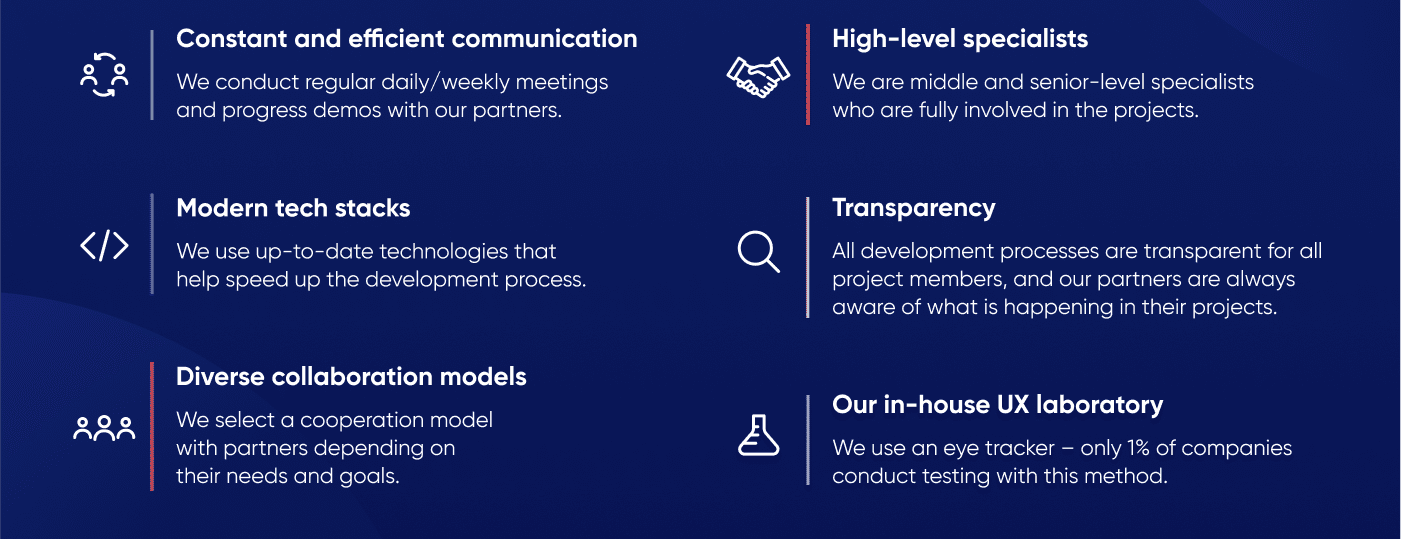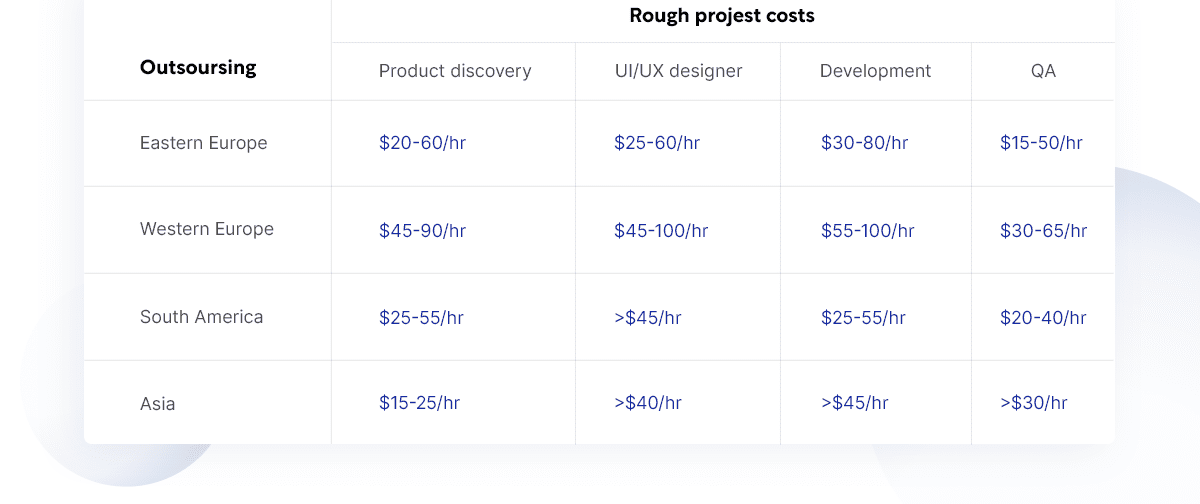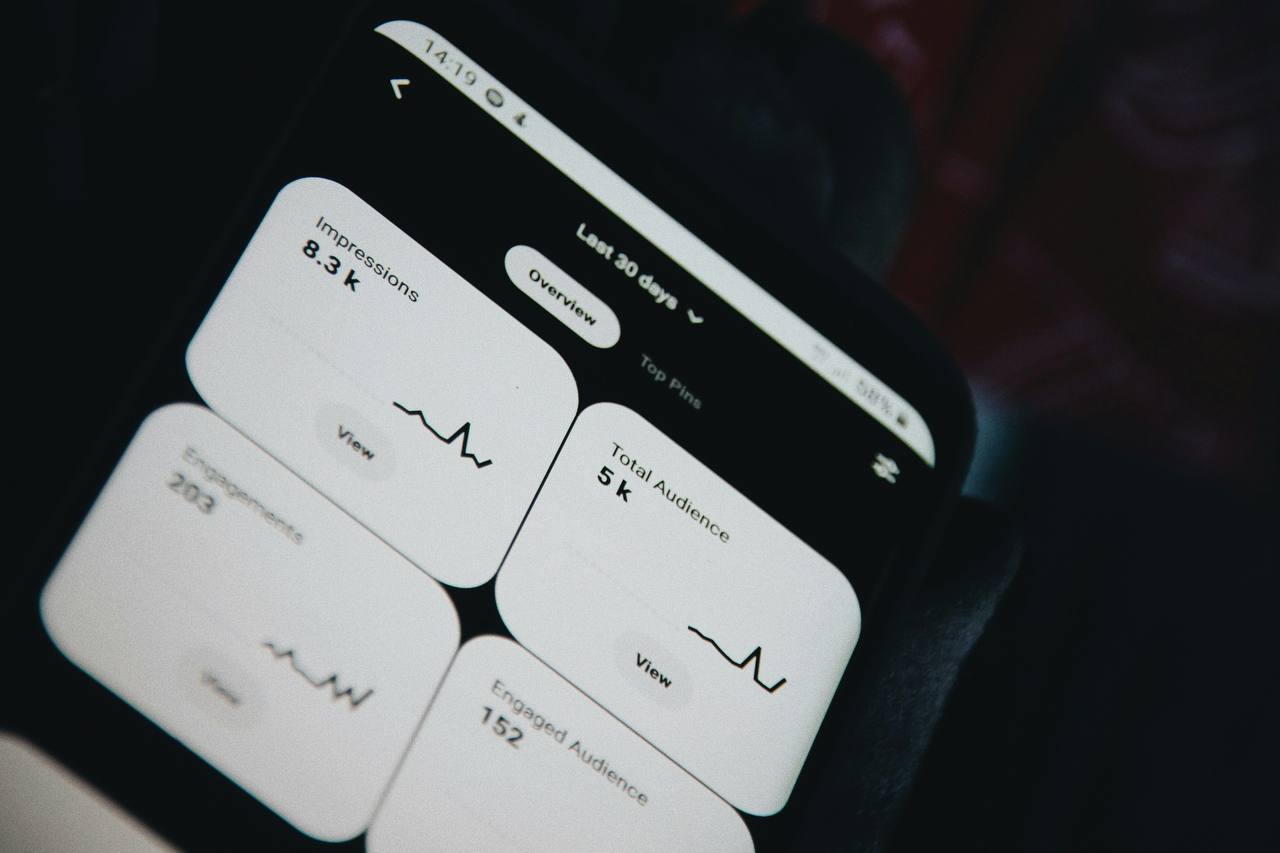If you are operating in finance, fintech, or a related industry, the word “trading” should not be new to you. This kind of financial operation has been trending lately. And, as more and more people get into it, the demand for relevant software increases rapidly.
Developing high-quality trading software isn’t easy. Such solutions have to deliver a broad range of features, compile with industry standards, show excellent performance, and, also, have many other specs that must be kept in mind during the process. But, custom software development can solve the problem.
How does it work? What are the main trends there? How much does it cost? In this article, we will tell you everything you need to know about custom trading software development. Let’s dive in!
Custom Trading Software Development: General Overview
According to Fortune Business Insights, the size of the global online trading platform market was estimated at $8.28 billion in 2020. During the Covid-19 pandemic, this market has seen surprising growth, as the demand for online trading solutions across different regions skyrocketed due to the global lockdown.
The market’s growth in 2020 was only 3.7%. Now, its CAGR has reached 5.1% and is predicted to stay at this level in the upcoming years.
According to industry experts, the size of this market will grow to $12.16 billion by 2028.
According to another research by Markets and Markets, the global cryptocurrency market, which was estimated at $1.6 billion in 2021, will be growing rapidly as well. Experts predict that it will grow at a CAGR of 7.1% and reach the point of $2.2 billion by 2026.
These stats demonstrate the stability and fast pace of the overall trading industry growth. Keeping this in mind, it makes pretty good sense for fintech and financial companies to start investing more in brokerage software development.
The Main Benefits of Custom Trading Software Development
While there is always the possibility to get an off-the-shelf solution, opting for custom stock trading software development can have many benefits, including:
Advanced Software Performance
Many off-the-shelf solutions have rather mediocre performance. Custom software, on the contrary, is built according to your unique needs and requirements, which allows ensuring higher performance.
Personalized Charts
An off-the-shelf solution can never be personalized enough to meet all your needs and goals. A custom trading solution, on the contrary, can help you achieve a much higher level of personalization for every user.
Smart Price Predictions
Custom software development often helps companies cut down development costs. At the same time, it also makes these costs more predictable because when you hire a dedicated team, all terms, deadlines, and costs are discussed at the early stages.
Industry Trends Integrating
The trading software market is growing and its trends are changing rapidly. Keeping up with all the changing trends in off-the-shelf solutions is nearly impossible. But, if you opt for custom development, you can ensure that your software is built according to the latest trends.
High Intuitive Interfaces
Trading can be very complex, so a perfect trading solution should be simple enough to make it intuitive for a user. As a rule, custom trading software is much more intuitive and user-friendly by default.
Better User Experience
Professional custom software service providers leverage the best design and development practices to create the best experiences for your users.
Top 5 Custom Trading Software Development Trends to Watch Out for in 2024
So, you’ve decided that you need stock or cryptocurrency trading software development to keep your business moving forward. Where do you start?
Below, we have gathered the top 5 biggest industry trends to keep in mind when developing your solutions in 2022:
Artificial Intelligence
AI is gradually entering all spheres of our lives, including trading. These days, AI trading is a growing trend in the fintech industry. So, if you are planning to engage in stock or cryptocurrency trading software development, you must pave the way for AI in 2022.
Trading solutions can leverage various AI tools, including algorithmic predictions, machine learning, etc. These tools can allow brokers to secure stocks, customize exchanges, receive more accurate predictions, and have overall better experiences.
Cloud Services
Cloud computing has been an ongoing trend in the trading industry for a while now. The biggest benefit of this technology is that it offers solution providers more flexibility and business continuity.
For companies looking to get into brokerage software development, leveraging this trend means cutting down costs and increasing efficiency. And for traders, solutions that offer connectivity through cloud platforms provide the possibility to work from literally anywhere.
Focus on Safety and Security
With the growing number of cyber threats, safety and security are among the top trends in all spheres, including trading software. Since trading is a fintech activity, the demand for high levels of security in this sector is huge.
By integrating deeper safety and security features into your software, you will keep your users protected from all kinds of threats and, thus, win their trust and loyalty.
Mobile-Friendly Development
In 2021, the overall number of active users of the world’s top 5 trading apps has reached 14 million. According to experts, the stock trading market has been shifting toward mobile for quite a while already. So, now, when the demand for such solutions is as high as ever, engaging in mobile-friendly stock trading software development is no longer an option but a necessity to stay competitive.
Customer-Centric Approach
Finally, one more trend to watch out for in brokerage software development is a customer-centric approach. In fact, this trend is mounting in all industries. With so many software solutions out there, getting potential customers’ attention is getting harder every year. To stay competitive and win over customers, software solution providers must deliver exceptional user experiences. Thus, keeping users’ opinions and needs at the top of your priorities list is a MUST.
Custom Trading Software Development: The Core Requirements
So, you already know about the top stock trading software development trends you should keep in mind to stay competitive and stand out from the crowd. Now, what are the core requirements without which you can’t enter the competition at all?
Here are a few of them to keep in mind:
Scalability
In brokerage software development, the flexibility and scalability of the solution stand for its ability to adapt to business growth. Truly, scalable solutions can be changed or edited down the line to meet the expanding needs of your business and ensure the longevity of the solution as you grow.
Security
When using trading software or apps, users share a big number of their personal and financial information along the way. There should be no security breaches if you want to keep your users happy. Therefore, security is the second core requirement that must be met.
Reliability
This requirement is also crucial for business success. Every custom trading solution must be carefully tested in every way to ensure that it works seamlessly, delivers excellent user experiences, and has the potential to contribute to your business growth.
High Performance
Top-rated trading software and apps come with many advanced features, including forecasts, reports, newsfeeds, filters, and much more. In order to keep your solution competitive, you must ensure that its performance is high enough to withstand all these features.
Interoperability
There are millions of potential users for your custom trading solution out there. In order not to miss any of them, you have to ensure that your solution operates well across different devices and systems. Therefore, interoperability is another top requirement you should keep in mind.
Key Features to Add to Your Custom Trading Software Development
When it comes to stock or cryptocurrency trading software development, there are plenty of features that you can include to stand out from the crowd. Yet, there is a list of core functionalities that must be involved in every solution:
User Profile
First of all, every trading app must have a solid authentication (login) feature for better security and a user profile too. The personal profile must be customizable and have a convenient dashboard to let users track and analyze their trading activity.
Placement of Trades
This should sound like a no-brainer, but every trading solution must have a reliable and convenient placement of trades feature to let users place their trades with ease.
Payments and Transactions
The financial features of custom trading software are the most important. Every user must have the possibility to buy and sell their assets freely. So, the more all-encompassing payment and transaction features are there, the better.
Notifications
Trading is a very dynamic activity. Often traders rely a lot on real-time market updates. Thus, adding convenient push notifications to your software is a must as it will let your users stay updated on everything going on in the market.
Newsfeed
This feature is pivotal in stock trading software development. Stock traders have to collect lots of valuable information and act fast in order to succeed. By adding a curated news feed to your solution, you can help your users stay updated on all news and important information, so it will make your solution much more convenient.
Filters
Searching for the right assets in extensive catalogs takes too much time and scrolling. But, if your app comes with a convenient search feature with customizable features, it will let traders find what they are looking for faster and easier.
Deposits
Every custom trading software should offer convenient means for making a deposit. Ideally, you should offer multiple supported payment options and secure all transactions to let your users make deposits in the most comfortable and protected way.
Reports and Analytics
Analytics and reporting also matter a lot in trading. At a bare minimum, high-quality trading software should grant users access to indicators, trading charts, and other analytical data that would help them track and assess their activities.
On top of that, every high-quality solution should let users not only monitor and analyze their trading activities but also generate detailed reports to get a deep dive into their wins and losses.
Updates
Trading Updates are regular announcements made by companies concerning their trading statuses and details. Such updates must be provided through every custom trading software to provide users with the information they need to trade successfully.
API
Lastly, integrating reliable APIs into your trading software will help your users level up their trading game. APIs enable brokers to integrate their preferred third-party software, automated algorithms, and tools into your solution. This is crucial for automated trading strategies.
How to Start Custom Trading Software Development [5 Main Steps]


Custom Trading Software Development
When you engage in stock trading software development, whether on your own or with professional help, below are the main steps that need to be taken:
Step 1: Conduct In-Depth Business Analysis and Formulate Your Idea
Every development project should kick off with extensive analysis and research. First of all, carefully analyze your business to understand what kind of solution you are looking for.
- If you want to create a proprietary (prop) trading solution, you should focus on developing desktop software.
- If the plan is to create a commercial trading solution, it is much wiser to stick to mobile development.
Alternatively, you can choose to develop a cross-platform solution. This way you will make your software more universal and, at the same time, will cut down development costs.
Apart from the type of software, you want to identify the goals and needs your business has for this project. Knowing the answers to all these questions, you should be able to formulate a clear and viable idea that will be at the heart of your project.
Step 2: Follow Necessary Regulatory Compliance
Trading is a rather tricky industry that is regulated by numerous financial and compliance standards. Breaking these regulations can mean huge financial losses. Namely, last year, one of the world’s biggest trading platforms Robinhood was fined $70 million by the Financial Industry Regulatory Authority (FINRA). This happened simply because the owners failed to follow the necessary regulatory compliance during the development stage.
If you want to avoid such issues (which, we bet, you do), it’s crucial to think about applicable financial and compliance standards in advance, before you engage in cryptocurrency trading software development. Ideally, you should hire developers with extensive industry experience to make sure that your future app operates within the general standards and regulations.
Step 3: Create UI/UX Design
Once the general software idea is identified and you are aware of all applicable regulations, you will need an expert UI/UX designer. This stage of the development process is when a design converts your ideas into a visual representation.
In some cases, at this stage, you will get a dynamic prototype of your future app that will later be used to test it for usability or confirm the design.
Step 4: Choose a Tech Stack and Start Development
Defining the right tech stack for your future solution is a hard one. In order to define what you’ll need, you have to analyze your basic requirements, such as:
- App type
- Infrastructure
- Unique features
Once you know your requirements, you have to pick the best technologies. Typically, a web-based trading platform will have three sides to it – frontend, backend, and DevOps. These days, the most popular technologies for front-end development are Angular and React.js. Both of these technologies have been proven to work well for such large-scale projects as stock trading software development. In terms of the backend, the most popular and reliable technologies are .Net and Java. And, as for DevOps, Docker and Jenkins are believed to be the most powerful options.
All in all, we recommend choosing tech stacks and programming languages based on the available resources and developers’ expertise.
When you finally have a specific tech stack in mind, the next stage of the process is development. During this stage, professional developers will convert your ideas and design into code and enrich your solution with all the features you want it to have.
Step 5: Testing and Maintenance
When the development phase is over, the complete solution moves on to the QA experts. These specialists have to conduct end-to-end testing of the software to ensure that it’s bug-free, functional, and ready for deployment.
Finally, after the product was tested and deployed, your work doesn’t stop there. In order to ensure success and growth, you have to invest time and money into your solution’s marketing and maintenance. You have to process user feedback, look for flaws, and run regular updates to keep your solution competitive and profitable.
Top 4 Answers Companies Ask Us About Custom Trading Software Development [+ RewiSoft Solutions]
Being a software development partner with extensive experience, the RewiSoft team receives loads of questions about different aspects of software development.
Below are some of the most common and big questions companies ask us about stock trading software development:
How to Build the Right Architecture for Software?
Typically, trading software lets every user access and manage multiple accounts, wallets, and interfaces, and use a variety of complex features simultaneously. With so many things present in a single piece of software, it can be hard to keep track of everything. So, when it comes to building app architecture, there might be numerous challenges waiting for you out there.
Solution: Of course, the primary goal is to create an intuitive architecture that would help users solve their complex trading challenges with ease. In order to do this, our team recommends building a complex customer journey map that would cover all the desired functions and actions a user might need to access in a trading solution. This map can serve as a great outline for your future app’s architecture.
Which Tech Stack Is Better to Choose?
As was already mentioned, selecting the right tech stack can be a real challenge. Unfortunately, there is no one-size-fits-all formula that would fit every project’s needs. Thus, the choice of the right technologies should be made based on the unique specs and requirements of your project.
Solution: There are some general recommendations on what tech stacks work best for different types of solutions. Namely, for web-based software, we recommend using React.js or Node.js. For cross-platform, you can pick React Native. For iOS, you can try Swift or Objective-C (language); iOS SDK or CocoaTouch/Multimedia (core); Firebase, Amplitude, AppsFlyer, or Facebook (analytics); and Realm, CoreData, UserDefaults, KeyChain, or CryptoSwift (data). For Android, a good tech stack can look as follows: Java or Kotlin (language); Android SDK or Android Jetpack (core); Firebase, Amplitude, AppsFlyer, or Facebook (analytics); and Realm, SQLite, Shared Preferences, or Room (data).
Please note that these are just general recommendations. The perfect tech stack can vary from one project to another. So, if you want to get it right but don’t know where to start, it is wise to get consultation and help from an experienced development partner.
How to Create Perfect UI/UX for Trading Software?
When it comes to creating UI/UX designs for trading software, it’s crucial to keep in mind the rich functionality and complicatedness of such platforms. With this in mind, creating the right design can feel like a massive challenge.
Solution: When working on UI/UX designs for trading software, the RewiSoft team strives for simplicity. The key goal of the design for such solutions is to make the complex and confusing trading process simple and intuitive for all users, including beginners. To achieve this, it is crucial to keep the logic and navigation behind such solutions simple. And, it is also important to keep the design light and not overloaded with an abundance of graphic elements. Everything should be simple, with just a few accent colors carefully selected according to the principles of color psychology.
What Is the Best Methodology to Use When Developing?
The methodology you select for software development will pre-determine the success of the entire project. These days, there are quite a few options to choose from, including Scrum, Waterfall, Kanban, Spiral, V-Model, Extreme Programming, and others. So, choosing the right approach isn’t easy.
Solution: Among all available methodologies, the RewiSoft team recommends using the agile approach. This methodology allows breaking up your project into shorter sprints (1-4 weeks), which helps you simplify the development process and stay ready for any changes you may face.
Custom Trading Software Development: RewiSoft Expertise


Why choose RewiSoft
If you are looking for custom trading solutions, RewiSoft is the best choice for you! Since 2019, our digital design & custom development company has been helping companies across numerous industries to bring their ideas to life and scale with ease. And trading software is among our areas of expertise too!
Throughout our vast experience, we’ve helped a number of companies looking to build top-rated trading software. For one of our clients, the RewiSoft team has developed an intuitive UI/UX design that makes buying ETFs simple and seamless even for beginners.
For another customer, we’ve created a feature-rich cryptocurrency trading app that makes it possible for traders to view 4 markets simultaneously, access clear data sets, track fluctuations in real-time, and do much more regardless of the level of a user’s experience.
And we can do the same for you! Dozens of customers who’ve already tried our services remained 100% satisfied with the outcomes, which is confirmed by RewiSoft’s high ratings on Clutch, Trustpilot, Google, etc.
Our company brings the best software development experts right to your doorstep to help you implement all your ideas and deliver top-level software solutions to your clients. So, don’t wait any longer and get professional custom trading development right now!
How Much Does It Cost to Develop Custom Trading Software?


Rough project costs
If you decide to get a trading solution for your business, you basically have two options:
- Buy an off-the-shelf solution;
- Opt for a custom solution.
The first option might be a little cheaper but it will limit you in terms of functionality and flexibility, and there is always a risk to end up with a solution that doesn’t address your unique business problems or objectives.
Requesting custom cryptocurrency trading software development, on the contrary, you will get a unique solution, perfectly tailored to your needs. The cost of a simple custom trading solution starts from $30,000. Whereas a more complicated solution can cost you from $40,000. This might be more expensive than off-the-shelf options. But such solutions will give you more flexibility and more opportunities for monetization too! And, most importantly, you will get a chance to outdo the competition.
Custom Trading Software Development: Conclusion
Given the rapid growth of the global online trading platform market, 2024 is the best time for finance and fintech companies to get into the biz and roll out their own trading software.
Without a doubt, getting on the right track with brokerage software development isn’t easy. But not now!
After reading this guide, you should have a better idea of the trading software market, the opportunities and challenges that are there, and the custom solutions that can help you attain your ambitious business goals. Knowing everything that we’ve shared with you here, you should be able to get on the right track with your projects. And don’t forget that the RewiSoft team is always here to help you succeed!










